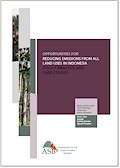| Report |
 |
|
| Title | Opportunities for reducing emissions from all land uses in Indonesia: policy analysis and case studies | | Author | Meine van Noordwijk, Fahmuddin Agus, Sonya Dewi, Andree Ekadinata, Hesti L. Tata, S. Suyanto, Gamma Galudra and Ujjwal Pradhan | | Year | 2010 | | Institution | World Agroforestry Centre - ICRAF, SEA Regional Office | | Number of Pages | 85 | | Call Number | RP0265-10 |
|
| Abstract: |
As a contribution to the wider debate on emission reduction from agriculture, forestry and other land uses in developing countries, this report explores the possibilities in Indonesia of broadening the current REDD+ category to include all land use and land-use changes.
This report provides an overview at two levels: the national debate in Indonesia and a compilation of case studies of specific landscapes where the local context shapes the debate.
At the case study sites there is a chance to change current land-use practices in order to establish higher carbon stock landscapes—while also providing for human livelihoods—if appropriate incentives can be derived from international co-investment and policy instruments.
Opportunities for reducing greenhouse gas emissions from Indonesia exist across all sectors of the economy and across a wide geographic area. However, in the international discussion so far, only two aspects have been recognised: actions in the energy and industrial sector that can obtain support from the Clean Development Mechanism (CDM); and efforts to reduce emissions from deforestation and degradation (REDD+). In theory, afforestation/reforestation following the Clean Development Mechanism’s afforestation/reforestation (A/R-CDM) rules can be supported, but in practice no single project in Indonesia has passed the screening filters and been submitted to the ‘designated national authority’ as an essential step towards international submission, review and approval.
All activity in enhancing tree-based carbon stocks has remained in the voluntary domain. A substantial part of Indonesia’s emissions derive from peatlands, some of which are within, and others outside of, the formal, government institutional ‘forest’ category and many other areas have contested status. Peatlands themselves need to be managed as hydrological entities if emissions are to be controlled and reduced.
Other aspects of land use on the edge of the REDD+ debate are the agroforests and tree-based landuse systems managed by farmers across Indonesia. While this vegetation usually meets international standards to be considered ‘forest’, the institutional interpretation of forest in Indonesia implies loss of sovereignty for communities and farmers across the country and so they prefer naming their systems ‘gardens’. The partial mismatch between the new international objective of emission reduction and the existing forest management institutions is part of the reason why efforts to ‘reduce emissions from all land uses’, or REALU, is an alternative worth exploring.
At the national scale, three discussions have evolved, with little cross-reference so far.
1) REDD+ efforts, that received a boost in 2007 in the lead-up to the 13th Conference of Parties (COP) of the United Nations Framework Convention on Climate Change (UNFCCC) in Bali with the reports of the Indonesian Forest Climate Alliance;
2) The private sector and its trial-and-error approach to learning from emerging new standards for ‘footprint’ in international trade; and
3) The pioneer commitments from Indonesia in the nationally appropriate mitigation actions (NAMA) arena, that found at least some recognition in the otherwise disappointing outcome of the 15th COP of the UNFCCC in Copenhagen in December 2009.
The site-level studies reported here are of landscapes in Sumatra and Kalimantan that cross the spectrum from forest conservation through recognition of agroforest management and restocking of trees in the landscape and peatland management to conversion to oil palm production. The most positive example of the consequences of the REDD+ debate has been the recognition of village (agro)forest management in a long-term Alternatives to Slash and Burn: Partnership for the Tropical
Forest Margins (ASB) research location in Jambi, Sumatra, which will hopefully act as a beacon for many others to follow. Most of the other case studies reveal that there would indeed be opportunities to reduce emissions, while enhancing local livelihoods, but that such opportunities require new ways of thinking about, and planning of, land use.
The case studies also reveal an inadequacy in the currently dominant ‘payment for ecosystem services’, or PES, paradigm. In the network of landscapes in Indonesia where experiments with this approach take place, water rather than carbon or biodiversity has been the primary issue, but in all cases success has depended on the building of trust—rather than clean buyer-seller financial relationships—between the external and local stakeholders.
A language of co-investment, sharing of risks and benefits and enhancement of reciprocity and responsibility has been the basis for success, not that of a market place. Appropriate ways for blending financial incentives with a broader approach based on ‘rights’ and ‘recognition’ are yet to evolve and gain the type of external interest that the PES paradigm has generated. |
|